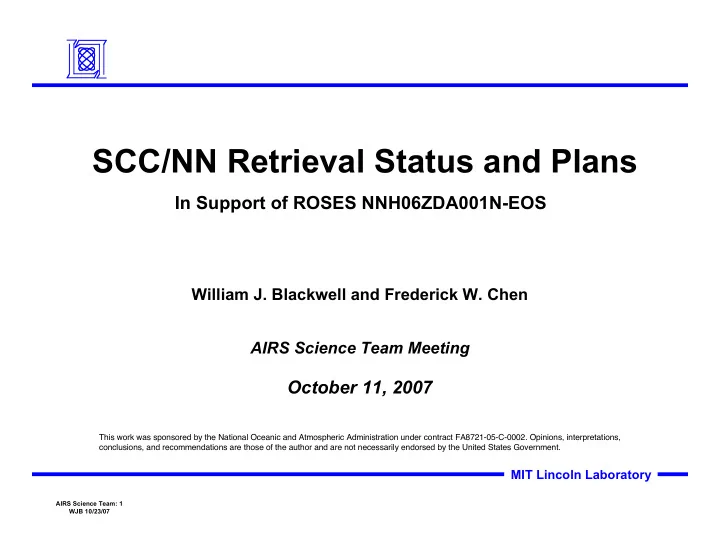

SCC/NN Retrieval Status and Plans In Support of ROSES NNH06ZDA001N-EOS William J. Blackwell and Frederick W. Chen AIRS Science Team Meeting October 11, 2007 This work was sponsored by the National Oceanic and Atmospheric Administration under contract FA8721-05-C-0002. Opinions, interpretations, conclusions, and recommendations are those of the author and are not necessarily endorsed by the United States Government. MIT Lincoln Laboratory AIRS Science Team: 1 WJB 10/23/07
Algorithm Improvement Activities • Preliminary forecast assimilation results (Prof. Kalnay and Hong Li) indicate problems with elevated surface terrain and polar regions – Further data stratification is needed to improve performance in these regions – Preliminary experiments are encouraging – (We think) these are the last remaining issues to be resolved before SCC/NN “Release 1.0” • Work is planned to: – Improve quality and quantity of QC flags – Retrieve spectral surface emissivity – Improve performance over land MIT Lincoln Laboratory AIR Science Team: 2 WJB 10/23/07
Planned IASI Activities • Adapt Stochastic Cloud Clearing for IASI – Non-uniform FOV effects may be corrected as part of the SCC algorithm – SCC algorithm uses PC signatures to characterize/correct clouds and can therefore be trained to ignore “corrupted” PC’s • Canonical correlation analysis (Projected PC) – Used as preprocessor for neural network estimation – Allows blending of radiance and temperature/moisture vector subspaces – We can therefore relate PC’s to geophysical quantities, which should help us identify/separate “signal” and “noise”. MIT Lincoln Laboratory AIR Science Team: 3 WJB 10/23/07
SCC/NN Release 1.0 • Fortran modules are in development that will be compatible with the NASA/NOAA Level 2 software – Thanks to Chris Barnet and John Blaisdell for help with this • SCC/NN retrieval can be “plugged in” to current system to provide alternate first-guess retrieval and/or cloud-cleared radiances for Version 6 testing – Subroutines for retrieval initialization and execution – Coefficient data read from binary file (probably HDF) • Primary objective: Improve Level 2 retrieval accuracy/yield in heavily clouded areas • Release planned for December 2007 MIT Lincoln Laboratory AIR Science Team: 4 WJB 10/23/07
Summary • Recent validation exercises with independent data indicate that global SCC/NN temperature and moisture profile retrieval accuracies are very good. • This testing has also identified problem areas (elevated terrain, polar regions) that we are working on. • We are shooting for a “Version 1.0” release of coefficients and code (Matlab and Fortran) at the end of this year. • Current algorithm work focused on the QC improvement (critical for Version 6 testing) and surface retrievals. • Related work with IASI is progressing. MIT Lincoln Laboratory AIR Science Team: 5 WJB 10/23/07
Backup Slides MIT Lincoln Laboratory AIR Science Team: 6 WJB 10/23/07
Algorithm Overview (Part I) • Temperature and moisture profile retrievals are produced in all cloud conditions • Cloud-cleared radiance estimates are produced for all 2378 AIRS channels • Retrieval is global: – All latitudes – Ocean and land – Day and night • Quality control has been implemented • IR-only option implemented • Very fast: Cloud-cleared radiances and retrieved profiles generated for one field of regard in ~1 msec using PC!! – Two-three orders of magnitude faster than current operational methods – One-two orders of magnitude faster than iterative, pseudochannel methods MIT Lincoln Laboratory AIR Science Team: 7 WJB 10/23/07
Algorithm Overview (Part II) • Algorithm is composed of linear and non-linear statistical operators – Projected principal components transform – Neural network estimation • Coefficients are derived empirically, off-line: – Co-location of sensor measurements with “truth” (Radiosondes, NWP, etc.) – Model-generated data – Data stratification is used for: Sensor scan angle Latitude Solar zenith angle Surface type Surface elevation MIT Lincoln Laboratory AIR Science Team: 8 WJB 10/23/07
Retrieval Performance Validation with AIRS/AMSU Case 1: ECMWF atmospheric fields • >500,000 co-located AIRS/AMSU/ECMWF observations from seven days: – 2002: Sep 6 – 2003: Jan 25, Jun 8, Aug 21, Sep 3, Oct 12, Dec 5 • ~100,000 profiles set aside for validation set Case 2: Radiosonde data ** NEW ** • ~2000 radiosondes from NOAA FSL global database co- located with AIRS/AMSU observations Global: Cloudy, Land & Ocean, Day & Night MIT Lincoln Laboratory AIR Science Team: 9 WJB 10/23/07
SCC/NN T(h) Retrieval (versus RAOBs) For comparison: AIRS L2 v4 Version 4 Version 4 Land, All latitudes, Radiosondes MIT Lincoln Laboratory AIR Science Team: 10 WJB 10/23/07
T(h) RMS Error Versus Cloud Fraction Common Ensemble (Qual_T_Top) Version 4 Land, All latitudes, Radiosondes MIT Lincoln Laboratory AIR Science Team: 11 WJB 10/23/07
SCC/NN W(h) Retrieval (versus RAOBs) For comparison: AIRS L2 v4 Version 4 Version 4 Land, All latitudes, Radiosondes MIT Lincoln Laboratory AIR Science Team: 12 WJB 10/23/07
Recommend
More recommend